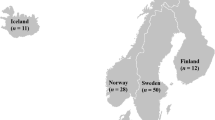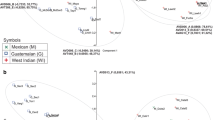Abstract
This study was conducted to determine if Brassica germplasm bulks created and maintained by the USDA-ARS North Central Plant Introduction Station (NCRPIS) were made with genetically indistinguishable component accessions and to examine newly identified putative duplicate accessions to determine if they can be bulked. Using ten microsatellite primer pairs, we genotyped two bulks of B. rapa L. ssp. dichotoma (Roxb.) Hanelt comprising four accessions and three bulks of B. rapa L. ssp. trilocularis (Roxb.) Hanelt comprising fourteen accessions, as well as four pairs of putatively duplicate accessions of B.␣napus L. Assignment tests on ten individual plants per accession were conducted using a model-based clustering method to arrive at probabilities of likelihood of accession assignment. The assignment tests indicated that one of the two bulks of B. rapa ssp. dichotoma involves genetically heterogeneous accessions. It was observed in the B. rapa ssp. trilocularis bulks that the component accessions could be differentiated into groups, with misassignments observed most frequent within groups. In B. napus, only one of the four pairs of putative duplicates showed significant genetic differentiation. The other three pairs of putative duplicates lack differences and support the creation of bulks. The results of the assignment tests were in agreement with cluster analyses and tests of population differentiation. Implications of these results in terms of germplasm management include the maintenance and/or re-creation of some Brassica germplasm bulks by excluding those accessions identified as being unique in this study.
Similar content being viewed by others
References
Cornuet JM, Luikart G (1996) Description and evaluation of two tests for detecting recent bottlenecks. Genetics 144:2001–2014
Cruz VMV (2006) Molecular genetic analysis of oilseed Brassica: determination of life forms and germplasm management strategies by using microsatellite markers and FLOWERING LOCUS C gene sequences. PhD dissertation. Iowa State University, Ames, Iowa
Davies N, Villablanco FX, Roderick GK (1999) Determining the source of individuals: multilocus genotyping in nonequilibrium population genetics. TREE 14(1):17–21
Dean RE, Dahlberg JA, Hopkins MS, Mitchell SE, Kresovich S (1999) Genetic redundancy and diversity among ‘Orange’ accessions in the U.S. national sorghum collection as assessed with simple sequence repeat (SSR) markers. Crop Sci 39:1215–1221
Eastham K, Sweet J, (2002) Genetically modified organisms (GMOs): the significance of gene flow through pollen transfer. EEA Environmental Issue Report No. 28. European Environment Agency, Copenhagen, Denmark
Hintum TJL, Knüpffer H (1995) Duplication within and between germplasm collections. I. Identifying duplication on the bases of passport data. Genet Res Crop Evol 42:127–133
Hintum TJL, Visser DL (1995) Duplication within and between germplasm collections. II. Duplication in four European barley collections. Genet Res Crop Evol 42:135–145
Hintum TJL, Boukema IW, Visser DL (1996) Reduction of duplication in a Brassica oleracea germplasm collection. Genet Res Crop Evol 43:343–349
Houmiel KL, Slater S, Broyles D, Casagrande L, Colburn S, Gonzalez K, Mitsky TA, Reiser SE, Shah D, Taylor NB (1999) Poly(beta-hydroxybutyrate) production in␣oilseed leukoplasts of Brassica napus. Planta 209:547–550
Khachatourians GG, Summer AK, Phillips PWB (2001) An introduction to the history of canola and the scientific basis of innovation. In: Phillips PWB, Khachatourians GG (eds) The biotechnology revolution in global agriculture. CABI, Wallingford, UK, pp␣33–47
Kimber DS, McGregor DI (1995) The species and their origin, cultivation and world production. In: Kimber DS, McGregor DI (eds), Brassica oilseeds: production and utilization. CABI, Oxon, UK, pp 1–8
Lund B, Ortiz R, Skovgaard IM, Waugh R, Anderson SB (2003) Analysis of potential duplicates in barley gene bank collections using re-sampling of microsatellite data. Theor Appl Genet 106:1129–1138
McNaughton IH (1995) Swedes and rapes – Brassica napus (Cruciferae). In: Smartt J, Simmonds NW (eds) Evolution of crop plants, 2nd edn. Longman Scientific & Technical, London, UK pp 68–75
Nei M (1972) Genetic distance between populations. American Naturalist 106:283–392
Peakall R, Smouse PE (2006) GenAlEx 6: genetic analysis in Excel. Population genetic software for teaching and research. Mol Ecol Notes 6:288–295
Petkau D, Calvert W, Stirling I, Strobeck C (1995) Microsatellite analysis of population structure in Canadian polar bears. Mol Ecol 4:347–354
Phippen WB, Kresovich S, Candelas FG, McFerson JR (1997) Molecular characterization can quantify and partition genetic variation among genebank holdings: a case study with phenotypically similar accessions of Brassica oleracea var. capitata L. (cabbage) ‘Golden Acre’. Theor Appl Genet 94:227–234
Primmer CR, Koskinen MT, Piironen J (2000) The one that did not get away: individual assignment using microsatellite data detects a case of fishing competition fraud. Proc R Soc Lond 267:1699–1701
Pritchard JK, Stephens M, Donnelly P (2000) Inference of population structure using multilocus genotype data. Genetics 155:945–959
Rakow G, Woods D (1987) Outcrossing in rape and mustard in Saskatchewan prairie conditions. Can J Plant Sci 67:147–151
Raymond M, Rousset F (1995) GENEPOP (version 1.2): population genetics software for exact tests and ecumenicism. J Heredity 86:248–249
Rice WR (1989) Analyzing tables of statistical tests. Evolution 43:223–225
Rohlf FJ (2005) NTSYS-pc: Numerical Taxonomy and Multivariate Analysis System, ver. 2.2. Exeter Software, Setauket, NY
Snowdon RJ, Friedt W (2004) Molecular markers in Brassica oilseed breeding: current status and future possibilities. Plant Breed 123:1–8
Treuren R, Hintum TJL (2003) Marker-assisted reduction of redundancy in germplasm collections: genetic and economic aspects. Acta Hort 623:139–149
Treuren R, Soest LMJ, Hintum TJL (2001) Marker-assisted rationalization of genetic resources collections: a case study in flax using AFLPs. Theor Appl Genet 103:144–152
Waser PM, Strobeck C (1998) Genetic signatures of interpopulation dispersal. TREE 13(2):43–44
Acknowledgements
This is a journal paper of the Iowa Agriculture and Home Economics Experiment Station, Ames, Iowa, Project No. 1018, and was supported by Hatch Act and the State of Iowa. The authors wish to thank Ms. Jody Hayes and Ms. Lori Lincoln (USDA-ARS Corn Insect and Crop Genetics Research Unit) for help in the laboratory, and Dr. Mark P. Widrlechner for reviewing the draft manuscript. Mention of commercial brand names in this paper does not constitute an endorsement of any product by the U.S. Department of Agriculture or cooperating agencies.
Author information
Authors and Affiliations
Corresponding author
Rights and permissions
About this article
Cite this article
Cruz, V.M.V., Nason, J.D., Luhman, R. et al. Analysis of bulked and redundant accessions of Brassica germplasm using assignment tests of microsatellite markers. Euphytica 152, 339–349 (2006). https://doi.org/10.1007/s10681-006-9221-5
Received:
Accepted:
Published:
Issue Date:
DOI: https://doi.org/10.1007/s10681-006-9221-5




